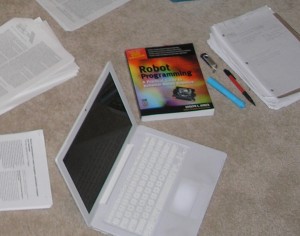I used to write papers in a very linear fashion.
I remember a paper for my intro cog sci class freshmen year, struggling to compose a decent introductory paragraph. I despaired over my first sentence. Transitions between themes, arguments, and discussions of evidence caused me agony. Even if I had all my research lined up, I couldn't write a later part because I hadn't written the part before it yet! A paper was a series of logical steps: How could I possibly know how best to start a paragraph without knowledge of the sentence prior?

My style has changed dramatically. Now, I write bits and pieces. If I know I'll be including a paragraph summarizing the work of a particular researcher, great, I can write that and have it ready when I need it. I construct bare-bones outlines, filling in details where I think they'll fit, making notes to myself of what need fleshing out and which sections are ready to go. Text gets moved around. Cut-paste. If I don't know how I'm supporting a particular argument yet, I can move on to what I do know and come back to the troublesome bit later. What I write doesn't have to be perfect the first time through.
I don't think know whether my new method saves me time. But I certainly feel more productive: I'm typing, even if I revise previously written paragraphs more frequently. Not expecting my writing to be perfect at the outset means I get more written down, which gives me more material to work with in my later revisions. I'm not staring at the screen, hesitantly trying out possible phrases, becoming the best friend of my "delete" key.
The blinking cursor at the top of a blank page is no longer my perpetual nemesis.





Sonia said:
That’s how I was taught to write papers in middle school, actually, and I *really* appreciate the teacher from whom I learned it. You write the outline first, then you flesh it out with your research in whatever order you happen across it in your notes, then you rearrange it for optimal flow, then you write the conclusions, THEN you write the introduction. Introduction should always be last!
Sept. 24, 2010, 4:55 a.m.
Jacqueline said:
Definitely good advice. I actually started writing papers using the “bits and pieces” method because a short story I wrote that way worked remarkably well, and I figured the method might apply just as well to academic writing!
Sept. 25, 2010, 3:49 p.m.